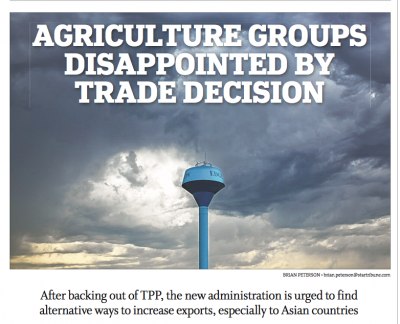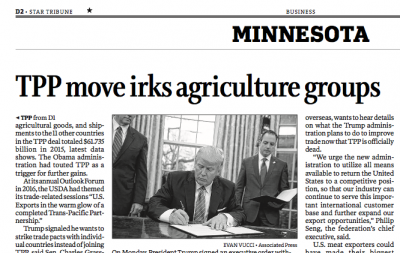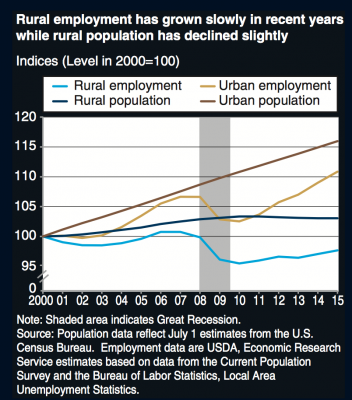China has bought at least 8 million tons of US soybeans this year, according to people familiar with the matter, putting the world’s top importer on track to meet a…
“Rural” Voters May Not Align with “Farm” Voters on Trade Issues
Donnelle Eller reported on the front page of Tuesday’s Des Moines Register that, “President Donald Trump’s decision to jettison the Trans-Pacific Partnership deal and renegotiate U.S. trade with Canada and Mexico could lead to a trade war that could put Iowa in the cross-hairs, worried state leaders told the Register on Monday.”
Frt pg todays @DMRegister Ag leaders: Trade war could harm Iowa,,https://t.co/W5AgiMDUkj by @DonnelleE - add'l info- https://t.co/nfHAADUy1S pic.twitter.com/Zvldqd8DBA
— Farm Policy (@FarmPolicy) January 24, 2017
Ms. Eller pointed out that:
In 2015, Iowa exported $7.8 billion in commodities to the 11 countries that were to be part of the TPP. Through November of 2016, Iowa exported $6.8 billion in commodities to those same countries.
The Register article added that, “‘I would hope that President Trump wouldn’t take action that could start a trade war, given that it would damage the very people who helped put him in office,’ said Dermot Hayes, an Iowa State University agricultural economist.”
Meanwhile, the front page of the business section in Wednesday’s Minneapolis Star-Tribune contained a Reuters article by Mark Weinraub, which stated that, “U.S. President Donald Trump’s decision to back out of the Trans-Pacific Partnership (TPP) trade deal, a $62 billion market for U.S. farmers, provides a fresh threat to a slumping agricultural economy that has grown increasingly dependent on exports.

“Agricultural groups expressed disappointment over the move and urged the new administration to find alternative ways to boost product shipments to Asian countries.”
The Reuters article reminded readers that, “Trump won nearly two-thirds of the rural vote in November, with big agricultural states including Iowa, Nebraska, Ohio and Indiana all lining up for the Republican.”

Mr. Weinraub highlighted the importance of U.S. soybean exports, and explained that, “A 10 percent jump in soybean shipments during the third quarter helped spur the biggest gross domestic product gains in two years. The U.S. Department of Agriculture (USDA) expects 2016-17 soy exports to hit a record 2.05 billion bushels, accounting for nearly half of the recently harvested U.S. crop.”
WSJ’s Daily Shot: Soybeans Still Swing US GDP - https://t.co/XlvOlzpE86 pic.twitter.com/B39SjjKpx2
— Farm Policy (@FarmPolicy) January 23, 2017
Despite the general unpopularity of President Trump’s trade actions this week among many agricultural groups, the reaction within the broader, and larger, context of all of rural America may not necessarily be the same.
In November, USDA’s Economic Research Service (ERS) pointed out (“Rural America at a Glance, 2016 Edition“) that, “The total population in rural (nonmetro) counties stood at 46.2 million in July 2015, representing 14 percent of U.S. residents in 72 percent of the Nation’s land area.”
The report noted that, “[T]he overall rural employment level remains well below its pre-recession level. Meanwhile, urban employment has risen more than twice as rapidly in recent years and was 4 percent above its 2007 level by 2015.”

The fact that rural areas have not experienced a full employment recovery to pre-Great Recession levels, could be a variable that leads to different economic perceptions on trade issues.
Craig Gilbert reported on the front page of the Milwaukee Journal Sentinel Wednesday that, “And in last fall’s election, Trump’s stand on trade got strong backing from the rural and blue collar whites — mostly Republican, but including many independents — who pushed him over the top in Wisconsin.
Wisconsin’s rural voters were far more opposed to trade deals than the state’s suburban or urban voters: 64% said trade pacts with other countries take away jobs, compared with 26% who said they create jobs, according to exit poll data provided by Edison Research.
“And among white blue-collar voters in Wisconsin, who backed Trump by large margins, 61% said trade deals take away jobs. Just 24% said they create jobs.”
Frt pg @journalsentinel Wisconsin’s RURAL voters more OPPOSED to trade deals than state’s suburban or urban voters: https://t.co/uCOuuF4CvA pic.twitter.com/ZnXkNePsvQ
— Farm Policy (@FarmPolicy) January 25, 2017
In addition to these political perceptions regarding trade in rural America, ERS also noted that, “Trends in agricultural prices have a disproportionate impact in farming-dependent counties, which accounted for 19.8 percent of all rural counties and 6 percent of the rural population in 2015. Declines in manufacturing employment, meanwhile, have particularly affected counties that are manufacturing-dependent—17.8 percent of rural counties with 22.5 percent of the rural population.”
With nearly four times as many rural Americans living in manufacturing dependent counties than in farming dependent counties, it may be difficult to predict how President Trump’s trade decisions will impact the “red”counties that made it possible for him to win the presidential election in November.
A Bloomberg article this week by Shannon Pettypiece and Alan Bjerga indicated that, “But manufacturing and service workers are more numerous in rural America, and Trump’s message was more narrowly focused on their needs than they were to agriculture’s, [Gary Blumenthal, president of World Perspectives Inc. in Washington] said.
‘When Trump is talking about trade he’s talking about factories,’ a big job generator in the industrial Midwest, where voters in small cities and rural areas gave Trump the victories that won him the White House, Blumenthal said. ‘Agriculture is a different fit.’
Meanwhile, in a separate Milwaukee Journal Sentinel article this week, Craig Gilbert noted that, “Those rural voters drawn to Trump out of economic frustration and a basic desire to shake things up may be the most likely to shift back if Trump doesn’t deliver or if Republicans overreach.”





